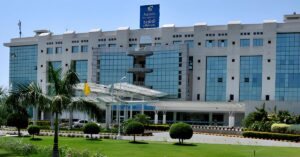Best Doctors in India for Optic Neuritis Treatment
Best Hospitals in India for Optic Neuritis Treatment
- City: Mumbai, India
Hospital Highlights:
- Fortis Hiranandani hospital was established in 2007.
- The hospital is an advanced tertiary care, multi-specialty hospital equipped with 149 beds.
- The hospital is equipped with a super ICU to provide emergency medical care to critically ill patients.
- The hospital is NABH accredited.
- The critical care facility in the hospital is augmented with the state-of-the-art facilities that facilitate speedier diagnosis and efficient monitoring.
- The hospital provides specialty medical services in cardiology, orthopedic science, pediatric science, neurology, diabetic care, urology, nephrology, ENT, obstetrics, gynecology, cosmetic surgery, bariatric surgery, neuro and spine care.
- City: Gurugram, India
Hospital Highlights:
- W Pratiksha Hospital, Gurugram, is one of the best hospitals in the NCR region. It is also a top hospital in India for IVF. Since its inception, the hospital has performed over 5500 successful IVFs. The hospital also specializes in gynecology.
- With over 20 years of experience in providing quality healthcare, the hospital is known as one of the most trusted and valued health providers in India.
- Equipped with world-class medical facilities and advanced technology, the hospital’s doctors and clinicians also have a track record of delivering excellent results. The hospital is also known for focusing on preventive well-being as much as on curative treatment.
- The hospital has earned the trust of its patients, by providing the best available treatments at affordable costs.
- City: Gurugram, India
Hospital Highlights:
- Paras hospital was established in 2006 and is the 250 bedded flagship hospital of Paras Healthcare.
- The is supported by a team of doctors of international and national repute.
- The hospital is NABH accredited and also the first hospital in the region to have a NABL accredited laboratory.
- The hospital provides specialty medical services in around 55 departments including Neurosciences, Joint Replacement, Mother & Child Care, Minimal Invasive Surgery, Gynecology and Obstetrics, Ophthalmology, Dermatology, Endocrinology, Rheumatology, Cosmetic and Plastic surgery.
- The hospital is equipped with state-of-the-art technologies.
- City: Kolkata, India
Hospital Highlights:
- Fortis Hospital, Anandapur, Kolkata is a world-class super-speciality equipped with the latest technologies in the medical world.
- The hospital is NABH accredited.
- This state-of-the-art facility specializes in cardiology and cardiac surgery, urology, nephrology, neurosciences, orthopaedics, digestive care, emergency care and critical care.
- The hospital, governed by integrated Building Management System (IBMS), has a pneumatic chute system, for quick vertical and horizontal transportation between floors, facilitating speedy transfer of patient specimens, documents, reports, and medicines to the concerned departments.
- The hospital also has a nephrology department with over 28 advanced dialysis units.
- City: Mumbai, India
Hospital Highlights:
- SL Raheja hospital is a 140-bed multi-specialty tertiary care hospital that is being managed by Fortis Healthcare Ltd.
- The hospital is a benchmark in healthcare and medical facilities in the neighborhood of Mahim & the western suburbs.
- L.Raheja Hospital, Mahim has one of the most effective ICU and Casualty care services.
- The hospital provides specialty medical services in Cardiology, Oncology, Neurology, Orthopedics, Mother & Child Care, and in Diabetes.
- City: Mumbai, India
Hospital Highlights:
- Wockhardt Hospitals were established in the year 1973, originally called First Hospitals and Heart Institute.
- Wockhardt Hospitals are super specialty health care networks in India, nurtured by Wockhardt Ltd, India’s 5th largest Pharmaceutical and Healthcare company.
- Wockhardt Hospitals is associated with Partners Harvard Medical International, an international arm of Harvard Medical School, USA.
- Wockhardt Heart Hospital performed India’s first endoscopic heart surgery.
- The hospital has a state-of-the-art infrastructure equipped with the latest technologies and modern equipment.
- It has special Centers of Excellence dedicated to the major specialties to provide hassle-free and high-quality clinical care.
- City: Gurugram, India
Hospital Highlights:
- The CK Birla Hospital in Gurugram is a NABH-accredited multi-specialty hospital.
- The hospital strives to increase the quality of healthcare by focusing on UK NHS nurse and midwife training requirements. Policies and practices derived from the National Institute for Health and Treatment Excellence (NICE) recommendations in the United Kingdom ensuring that a strong focus on safety, high-quality clinical care, and sanitation is maintained.
- The hospital’s cutting-edge technology and facilities allow for real-time communication and seamless collaboration among caregivers, ensuring accuracy and the best possible results. Those with foreign experience and accreditations make up part of the hospital’s team of clinicians.
- City: Ahmedabad
Hospital Highlights:
- As a member of the Apollo Hospitals Group, Apollo Hospitals International Limited, Ahmedabad is one of the most popular and sought-after medical facilities in Gujarat.
- Through its 6 Centres of Excellence and various affiliated branches, which cover all specialties and subspecialties, the hospital provides the most advanced clinical services.
- Since its inception in 2003, the hospital has been providing each patient with the most up-to-date medical equipment and state-of-the-art technology.
- With more than 150 successful organ transplants, including liver and renal transplants, the facility has been able to build a strong and extensive organ transplant program.
- In addition to performing 600 surgeries and caring for over 1800 patients on an IP basis, the hospital sees more than 18,000 patients on average in the outpatient department.
- With one of the biggest cardiology teams in the area, the hospital provides state-of-the-art regional care treatment in Cardiac Sciences.
- Additionally, the hospital offers a broad range of Neuro Interventional techniques to help stroke patients recover more quickly.
- City: Noida, India
Hospital Highlights:
- Jaypee Hospital is the flagship hospital of the Jaypee Group.
- This hospital has commissioned 525 beds in the first phase and has been planned and designed as a 1200 bedded multi-specialty facility.
- It holds the accreditation of the NABH and NABL.
- The hospital has state-of-the-art infrastructure equipped with the latest technologies and modern equipment like 64 Slice PET CT, Dual Head 6 Slice SPECT CT, Gamma Camera, and Da Vinci Robotic Surgery for comprehensive robotic surgical solutions.
- It has special Centers dedicated to the major specialties to provide hassle-free and high-quality clinical care.
- City: Mumbai, India
Hospital Highlights:
- Reliance Hospital is one of the best super-specialty care hospitals in Navi Mumbai.
- The main purpose of this hospital is to become a trustworthy place for the best health and hope for society. The hospital is well connected to the suburbs of Mumbai and Navi Mumbai.
- The hospital has various specialty departments, viz., Accident & Emergency, Anesthesiology, Dental Services, Dermatology, Diabetology, Dietetics Nutrition, Endocrinology, ENT, Gastroenterology, General Surgery, Gynaecology And Obstetrics, Hepato Pancreato Biliary Surgery, Infectious Disease, Internal Medicine, Interventional Radiology, Laboratory Medicine, Minimal Access Laparoscopic Surgery, Nephrology, Neurosciences, Opthalmology, Orthopaedics, Paediatrics, Pain Management Palliative Care, Physical Medicine Rehabilitation, Plastic And Reconstructive Surgery, Psychiatry, Pulmonary Medicine, Radiology, Rheumatology, Transplant, Urology Andrology, Vascular Surgery
Optic Neuritis
Your optic nerve performs the function of carrying visual information from the eye to the brain. When this optic nerve becomes inflamed, this condition is known as optic neuritis. This condition can flare up suddenly due to an infection or nerve disease. The inflammation can also cause temporary vision loss, which typically happens in only one eye. People with optic neuritis also occasionally experience pain. However, as the patient recovers and the inflammation goes away, the vision is likely to return.
Optic neuritis doesn’t always require treatment and heals on its own. Medications can help in a speedy recovery, in most cases, though it might take up to 12 months to achieve the full recovery of the vision.
Symptoms
Generally, only one eye is affected by optic neuritis. Symptoms may include the following:
- Pain- Most of the people who develop this condition have eye pain which gets worsened by eye movement. Sometimes this pain might feel like a dull ache behind the eye.
- Loss of color vision- Optic neuritis might also affect color perception, and therefore you may notice that colors are appearing less vivid than normal.
- Flashing lights- People having optic neuritis also sometimes report seeing flashing or flickering lights with eye movements.
- Vision loss in one eye- Many people with this condition have at least some temporary reduction in vision, but the extent can vary. Noticeable vision loss generally takes hours or days and improves over several weeks to months. The vision loss might also be permanent for some people.
- Visual field loss- Patients with this condition may also experience side vision loss in any pattern, such as central vision loss or peripheral vision loss.
Causes & risk factors
Optic neuritis might be caused by nerve diseases such as:
- Multiple sclerosis
- Neuromyelitis Optica
- Schilder’s disease
The condition might also be caused by some infections such as:
- Mumps
- Meningitis
- Shingles
- Measles
- Tuberculosis
- Sinusitis
- Lyme disease
- Viral encephalitis
Other causes of optic neuritis include:
- Sarcoidosis, a condition that causes inflammation in several organs and tissues of your body
- Certain drugs or chemicals
- Guillain-Barre syndrome, a disease in which your nervous system is attacked by your own immune system
- Post-vaccination reaction, i.e. an immune response that may follow a vaccination
Some of the risk factors that can lead to optic neuritis include: - Age- Optic neuritis generally affects adults between the ages of 20 and 40.
- Race- Optic neuritis is also known to occur more among people of white ethnicity.
- Sex- Women are more likely to develop this condition as compared to men.
- Genetic mutations- There are also certain genetic mutations that can also increase your risk of developing optic neuritis.
Diagnosis
You will mostly like to see an ophthalmologist for the diagnosis. He/she will need to know your medical history and perform a routine exam. The following exams might also be required:
Ophthalmoscopy
In ophthalmoscopy exam, your doctor will be shining a bright light into your eye and examine the structures located at the back of your eye. This test is meant to evaluate the optic disk, where the optic nerve enters the retina in your eye. The optic disk might also get swollen in over thirty percent of people having optic neuritis.
Pupillary light reaction test
In pupillary light reaction test, your doctor can move a flashlight in front of your eyes to see how your pupils are responding when exposed to bright light. If you are having optic neuritis, your pupils are not going to constrict as much as pupils in healthy eyes would when they are exposed to light.
Your doctor might also recommend other tests such as MRI, OCT (optical coherence tomography, blood tests, or a visual field test.
Treatment
In most cases, optic neuritis usually improves on its own. However, in some cases, steroid medications are used for reducing inflammation of the optic nerve. Some of the possible side effects of steroid treatment generally include weight gain, mood changes, stomach upset problems, facial flushing, and insomnia.
Generally, steroid treatment is given intravenously, and it helps to quicken the vision recovery, though it doesn’t seem to affect the amount of vision recovery. There is also a treatment known as plasma exchange therapy, which might help some people recover their vision, but it hasn’t been confirmed via any studies that plasma exchange therapy is effective for optic neuritis.
Complications
- Optic nerve damage- Most people generally experience some level of permanent optic nerve damage after an episode of optic neuritis, but the damage may not lead to any permanent symptoms.
- Decreased visual acuity- Although most people are able to regain normal or near-normal vision within some months, a partial loss of color discrimination may persist in some cases. For some people, vision loss might also persist.
- Side effects of treatment- Steroid medications that are used to treat optic neuritis can subdue your immune system, which may cause the body to become more susceptible to infections. Other side effects are also there such as mood changes as well as weight gain.












